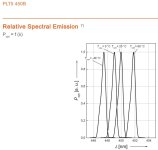- Joined
- Jun 12, 2015
- Messages
- 7,763
- Points
- 113
Hi all,
Just putting in a request for any spectral data anyone has on the NUBM44-V2.
I need to know what wavelength the diode is at their chosen current setting.
I would need the voltage, current and output power to go alongside, as I am trying to determine whether they are possible to cool down to <445nm and how the current affects the central wavelength.
Thanks,
Curtis
Just putting in a request for any spectral data anyone has on the NUBM44-V2.
I need to know what wavelength the diode is at their chosen current setting.
I would need the voltage, current and output power to go alongside, as I am trying to determine whether they are possible to cool down to <445nm and how the current affects the central wavelength.
Thanks,
Curtis






